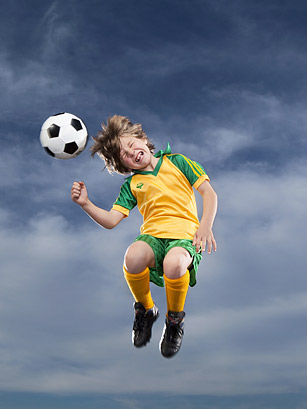
(3 of 4)
It's not possible to diagnose anything like CTE from just those symptoms, particularly because Michael's recent academic problems began before his concussion. But he already had a history of what he calls stingers, or head blows — none of which kept him off the field. What's more, his coach allowed him to return to play only a month or so after his recent concussion, a game in which he took another blow to the head, then lost his temper and got ejected.
Michael is hardly the only student athlete playing roulette with his brain, and his coach is hardly alone in abetting such recklessness. One study has shown that up to 40% of players who experience a concussion are back on the field before their brains have fully healed. That, Gioia says, is especially worrisome since sometimes two mild injuries can do more damage than one severe one. In some cases — mercifully rare — players who return to the field before they're fully recovered may even suffer what is known as malignant brain edema, or second-impact syndrome, in which another blow to the head leads to a fatal brain bleed. About half a dozen kids per year die from second impact.
It's easy enough to make the case that any person who has suffered a brain injury needs a long period of recuperation before returning to vigorous physical activity. But what about vigorous intellectual activity? The brain is a cognitive machine, and it requires an enormous amount of energy to keep its gears moving. That's a fact concussed kids often confront when they resume their classwork after an injury and find that their symptoms return the moment they crack a book. "Cognitive exertion requires a high degree of metabolic activity," says Gioia. "If you have a brain that's already impaired, that ability is going to be reduced."
Mary, a high school junior and another patient at Gioia's clinic, has suffered three concussions over the past three years as a goalie for her soccer team. Surprisingly, it is not heading the ball that leads to most concussions in soccer — though the limited studies that have been done have looked only at young adults, and none have explored subconcussive injury. Rather, the damage is done mostly by collisions with other players or, as in Mary's case, with equipment. Her third concussion came last November, when she hit her head against the frame of the goal. She remains an honors student in the International Baccalaureate program in her high school, but the struggle to keep up that level of academic excellence has been grueling.
"I didn't have any exams until two months after the injury," she says. "But when I did, the headaches and fatigue came back immediately. I lost focus during one test and had no idea what I'd just written." She got through all the same and has gone back to school full time, but every day is a battle with pain, exhaustion and sensitivity to noise and light. She has also accepted that soccer — which was a passion — is just not an option anymore. "I can't afford another concussion," she says.
Digging Deep
The fact that no two concussions follow the same recovery arc is one of the things that makes them so challenging to diagnose and treat. But that same particularity of injury also provides scientists insights into which people are at the greatest concussive risk.
Gender, for one thing, seems to play a role. Mary may be recovering faster from her injury than Michael is, but on the whole, females are both more susceptible to concussions than males are and suffer more-severe symptoms. So far, the reason for that gap is unclear. There is some thought that a girl's comparatively weaker neck muscles may leave her head more susceptible to violent shock. Hormones too may play a role. Among epileptic girls and women, rising and falling estrogen levels are known to make the brain more or less vulnerable to seizures. The thinking is that this may apply to concussion symptoms as well — though it's unclear whether a girl's hormonal makeup leaves her more concussion-prone throughout the month or just during menstruation.
Genes may also be involved. The fact is, plenty of athletes make it through their careers battered and scarred but cerebrally intact, while others who may not get hit with any greater frequency suffer all manner of brain damage. Researchers at the Children's National Medical Center are studying the genomes of both concussed and nonconcussed kids, looking for markers that may explain the difference.
"There could be a genetic predisposition that affects metabolic activity," says geneticist Susan Knoblach. "People always assume that there's a genetic component in degenerative conditions but not acute ones, but of course there can be."